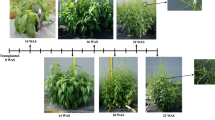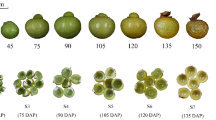Abstract
Introduction
Phoenix dactylifera L. (date palm) is one of the most valued crops worldwide for its economical and nutraceutical applications of its date fruit (pericarp). Currently date pits, considered as a waste product, is employed as coffee substitute post roasting. Whereas, pollen represents another valuable by-product used as a dietary supplement.
Objectives
In this study, a large-scale comparative metabolomics approach was performed for the first characterization and standardization of date palm by-products viz., date pits and pollen. Moreover, roasting impact on date pit metabolite composition was also assessed.
Methods
Metabolites profiling of pits and pollen was determined via a multiplex approach of UPLC–MS and NMR, coupled to multivariate analysis, in relation to its antioxidant activities.
Results
Chemical analyses led to the identification of 67 metabolites viz., phenolic acids, flavonols, fatty acids, sphingolipids, steroids and saponins of which 10 are first time to be reported. The enrichment of steroids in date pollen accounts for its fertility promoting properties, whereas date pit was found a rich source for antioxidant polyphenols using metabolomics.



Similar content being viewed by others
Abbreviations
- C:
-
Coffee product
- DPP:
-
Date palm pollen
- DPPH:
-
2, 2-Diphenyl-1-picrylhydrazyl reagent
- IC:
-
Inhibition concentration
- NMR:
-
Nuclear magnetic resonance
- OPLS-DA:
-
Partial least squares-discriminant analysis
- P. :
-
Phoenix
- PCA:
-
Principal component analysis
- RW:
-
Raw date pits
- RS:
-
Roasted date pits
- UPLC:
-
Ultra performance liquid chromatography
References
Abu-Reidah, I. M., Gil-Izquierdo, Á., Medina, S., & Ferreres, F. (2017). Phenolic composition profiling of different edible parts and by-products of date palm (Phoenix dactylifera L.) by using HPLC-DAD-ESI/MSn. Food Research International, 100, 494–500. https://doi.org/10.1016/j.foodres.2016.10.018.
Ahmed, A., Arshad, M. U., Saeed, F., Ahmed, R. S., & Chatha, S. A. S. (2016). Nutritional probing and HPLC profiling of roasted date pit powder. Pakistan Journal of Nutrition, 15, 229–237. https://doi.org/10.3923/pjn.2016.229.237.
Al Juhaimi, F., Özcan, M. M., Adiamo, O. Q., Alsawmahi, O. N., Ghafoor, K., & Babiker, E. E. (2018). Effect of date varieties on physico-chemical properties, fatty acid composition, tocopherol contents, and phenolic compounds of some date seed and oils. Journal of Food Processing and Preservation, 42, e13584. https://doi.org/10.1111/jfpp.13584.
Alberti-Dér, Á. (2013). LC-ESI-MSMS methods in profiling of flavonoid glycosides and phenolic acids in traditional medicinal plants Sempervivum tectorum L. and Corylus avellana L. PHD, Semmelweis University.
Al-Shahib, W., & Marshall, R. J. (2003). The fruit of the date palm: Its possible use as the best food for the future? International Journal of Food Sciences and Nutrition, 54, 247–259. https://doi.org/10.1080/09637480120091982.
Asami, A., Hirai, Y., & Shoji, J. (1991). Studies on the constituents of Palmae plants. VI. Steroid saponins and flavonoids of leaves of Phoenix canariensis hort. ex Chabaud, P. humilis Royle var. hanceana Becc., P. dactylifera L., and Licuala spinosa Wurmb. Chemical & Pharmaceutical Bulletin, 39, 2053–2056. https://doi.org/10.1248/cpb.39.2053.
Baliga, M. S., Baliga, B. R. V., Kandathil, S. M., Bhat, H. P., & Vayalil, P. K. (2011). A review of the chemistry and pharmacology of the date fruits (Phoenix dactylifera L.). Food Research International, 44, 1812–1822. https://doi.org/10.1016/j.foodres.2010.07.004.
Buffo, R. A., & Cardelli-Freire, C. (2004). Coffee flavour: An overview. Flavour and Fragrance Journal, 19, 99–104. https://doi.org/10.1002/ffj.1325.
Croley, T. R., Hughes, R. J., Koenig, B. G., Metcalfe, C. D., & March, R. E. (2000). Mass spectrometry applied to the analysis of estrogens in the environment. Rapid Communications in Mass Spectrometry, 14, 1087–1093. https://doi.org/10.1002/1097-0231(20000715)14:13%3c1087:AID-RCM992%3e3.0.CO;2-3.
Cuyckens, F., Rozenberg, R., de Hoffmann, E., & Claeys, M. (2001). Structure characterization of flavonoid O-diglycosides by positive and negative nano-electrospray ionization ion trap mass spectrometry. Journal of Mass Spectrometry, 36, 1203–1210. https://doi.org/10.1002/jms.224.
Elisha, I. L., Dzoyem, J. P., McGaw, L. J., Botha, F. S., & Eloff, J. N. (2016). The anti-arthritic, anti-inflammatory, antioxidant activity and relationships with total phenolics and total flavonoids of nine South African plants used traditionally to treat arthritis. BMC Complementary and Alternative Medicine, 16, 1–10. https://doi.org/10.1186/s12906-016-1301-z.
Farag, M. A., Handoussa, H., Fekry, M. I., & Wessjohann, L. A. (2016). Metabolite profiling in 18 Saudi date palm fruit cultivars and their antioxidant potential via UPLC-qTOF-MS and multivariate data analyses. Food & Function, 7, 1077–1086. https://doi.org/10.1039/C5FO01570G.
Farag, M. A., Mohsen, M., Heinke, R., & Wessjohann, L. A. (2014). Metabolomic fingerprints of 21 date palm fruit varieties from Egypt using UPLC/PDA/ESI–qTOF-MS and GC–MS analyzed by chemometrics. Food Research International, 64, 218–226. https://doi.org/10.1016/j.foodres.2014.06.021.
Farag, M. A., Porzel, A., Schmidt, J., & Wessjohann, L. A. (2012a). Metabolite profiling and fingerprinting of commercial cultivars of Humulus lupulus L. (hop): A comparison of MS and NMR methods in metabolomics. Metabolomics, 8, 492–507. https://doi.org/10.1007/s11306-011-0335-y.
Farag, M. A., Porzel, A., & Wessjohann, L. A. (2012b). Comparative metabolite profiling and fingerprinting of medicinal licorice roots using a multiplex approach of GC-MS, LC-MS and 1D NMR techniques. Phytochemistry, 76, 60–72. https://doi.org/10.1016/j.phytochem.2011.12.010.
Ferreres, F., Llorach, R., & Gil-Izquierdo, A. (2004). Characterization of the interglycosidic linkage in di-, tri-, tetra- and pentaglycosylated flavonoids and differentiation of positional isomers by liquid chromatography/electrospray ionization tandem mass spectrometry. Journal of Mass Spectrometry, 39, 312–321. https://doi.org/10.1002/jms.586.
Hamed, A. I., Ben Said, R., Al-Ayed, A. S., Moldoch, J., Mahalel, U. A., Mahmoud, A. M., et al. (2017). Fingerprinting of strong spermatogenesis steroidal saponins in male flowers of Phoenix dactylifera (Date Palm) by LC-ESI-MS. Natural Product Research, 31, 2024–2031. https://doi.org/10.1080/14786419.2016.1274887.
Hammouda, H., Cherif, J. K., Trabelsi-Ayadi, M., Baron, A., & Guyot, S. (2013). Detailed polyphenol and tannin composition and its variability in Tunisian dates (Phoenix dactylifera L.) at different maturity stages. Journal of Agricultural and Food Chemistry, 61, 3252–3263. https://doi.org/10.1021/jf304614j.
Harborne, J. B., & Baxter, H. (1993). Phytochemical dictionary: A handbook of bioactive compounds from plants. London: CRC Press.
Hong, Y. J., Tomas-Barberan, F. A., Kader, A. A., & Mitchell, A. E. (2006). The flavonoid glycosides and procyanidin composition of Deglet Noor dates (Phoenix dactylifera). Journal of Agricultural and Food Chemistry, 54, 2405–2411. https://doi.org/10.1021/jf0581776.
Jin, Y., Xiao, Y.-S., Zhang, F.-F., Xue, X.-Y., Xu, Q., & Liang, X.-M. (2008). Systematic screening and characterization of flavonoid glycosides in Carthamus tinctorius L. by liquid chromatography/UV diode-array detection/electrospray ionization tandem mass spectrometry. Journal of Pharmaceutical and Biomedical Analysis, 46, 418–430.
Juhaimi, F. A., Ghafoor, K., & Ozcan, M. M. (2012). Physical and chemical properties, antioxidant activity, total phenol and mineral profile of seeds of seven different date fruit (Phoenix dactylifera L.) varieties. International Journal of Food Sciences and Nutrition, 63, 84–89. https://doi.org/10.3109/09637486.2011.598851.
Kazuno, S., Yanagida, M., Shindo, N., & Murayama, K. (2005). Mass spectrometric identification and quantification of glycosyl flavonoids, including dihydrochalcones with neutral loss scan mode. Analytical Biochemistry, 347, 182–192.
Ma, Y., Li, Q., Van den Heuvel, H., & Claeys, M. (1997). Characterization of flavone and flavonol aglycones by collision-induced dissociation tandem mass spectrometry. Rapid Communications in Mass Spectrometry, 11, 1357–1364.
Mabry, V. T. J., Markham, K. R., Thomas, M. B., & Graf, E. (1970). The Systematic Identification of Flavonoids. Archiv der Pharmazie, 304, 715. https://doi.org/10.1002/ardp.19713040918.
Pérez-Magariño, S., Revilla, I., González-SanJosé, M. L., & Beltrán, S. (1999). Various applications of liquid chromatography–mass spectrometry to the analysis of phenolic compounds. Journal of Chromatography A, 847, 75–81. https://doi.org/10.1016/S0021-9673(99)00255-1.
Poisson, L., Blank, I., Dunkel, A., & Hofmann, T. (2017). Chapter 12—The chemistry of roasting—Decoding flavor formation The Craft and Science of Coffee (pp. 273–309). London: Academic Press.
Ramabulana, T. (2016). UPLC-MS based metabolomics investigation on the effects of gamma radiation on nutraceutical plants. PHD: University of Johannesburg.
Rasheed, D. M., Porzel, A., Frolov, A., El Seedi, H. R., Wessjohann, L. A., & Farag, M. A. (2018). Comparative analysis of Hibiscus sabdariffa (roselle) hot and cold extracts in respect to their potential for α-glucosidase inhibition. Food Chemistry, 250, 236–244. https://doi.org/10.1016/j.foodchem.2018.01.020.
Saito, T., Yamane, H., Murofushi, N., Takahashi, N., & Phinney, B. O. (1997). 4-O-Caffeoylshikimic and 4-O-(p-coumaroyl)shikimic acids from the Dwarf Tree Fern, Dicksonia antarctica. Bioscience, Biotechnology, and Biochemistry, 61, 1397–1398. https://doi.org/10.1271/bbb.61.1397.
Sánchez-Rabaneda, F., Jauregui, O., Lamuela-Raventós, R. M., Viladomat, F., Bastida, J., & Codina, C. (2004). Qualitative analysis of phenolic compounds in apple pomace using liquid chromatography coupled to mass spectrometry in tandem mode. Rapid Communications in Mass Spectrometry, 18, 553–563.
Scherer, M., Leuthäuser-Jaschinski, K., Ecker, J., Schmitz, G., & Liebisch, G. (2010). A rapid and quantitative LC-MS/MS method to profile sphingolipids. Journal of Lipid Research, 51, 2001–2011.
Schmeda-Hirschmann, G., Razmilic, I., Gutierrez, M. I., & Loyola, J. I. (1999). Proximate composition and biological activity of food plants gathered by Chilean Amerindians. Economic Botany, 53, 177–187.
Smith, C. A., Want, E. J., O’Maille, G., Abagyan, R., & Siuzdak, G. (2006). XCMS: Processing mass spectrometry data for metabolite profiling using nonlinear peak alignment, matching, and identification. Analytical Chemistry, 78, 779–787. https://doi.org/10.1021/ac051437y.
Suresh, S., Guizani, N., Al-Ruzeiki, M., Al-Hadhrami, A., Al-Dohani, H., Al-Kindi, I., et al. (2013). Thermal characteristics, chemical composition and polyphenol contents of date-pits powder. Journal of Food Engineering, 119, 668–679. https://doi.org/10.1016/j.jfoodeng.2013.06.026.
Vlahov, G. (1999). Application of NMR to the study of olive oils. Progress in Nuclear Magnetic Resonance Spectroscopy, 35, 341–357.
Wojdyło, A., Oszmiański, J., & Czemerys, R. (2007). Antioxidant activity and phenolic compounds in 32 selected herbs. Food Chemistry, 105, 940–949. https://doi.org/10.1016/j.foodchem.2007.04.038.
Wollgast, J., Pallaroni, L., Agazzi, M.-E., & Anklam, E. (2001). Analysis of procyanidins in chocolate by reversed-phase high-performance liquid chromatography with electrospray ionisation mass spectrometric and tandem mass spectrometric detection. Journal of Chromatography A, 926, 211–220.
Yakovishin, L., Lekar, A., Vetrova, E., Borisenko, N., Borisenko, S., & Grishkovets, V. (2012). Molecular complexes of the triterpene glycosides with l-tyrosine and their biological activity. Biopolymers and Cell, 28, 62–67.
Zargari, A. (1997). Medical Plants, vol. 3 (6th ed.). University of Tehran Press: Tehran.
Zhang, Q., Zhang, J., Shen, J., Silva, A., Dennis, D. A., & Barrow, C. J. (2006). A simple 96-well microplate method for estimation of total polyphenol content in seaweeds. Journal of Applied Phycology, 18, 445–450. https://doi.org/10.1007/s10811-006-9048-4.
Acknowledgements
Dr. Mohamed A. Farag is grateful to Dr. Andrea Porzel for assistance with NMR analysis, Leibniz Institute for Plant Biochemistry, Halle, Germany. He also acknowledges the funding received from Jesour grant number 30, ASRT, Egypt and the Alexander von Humboldt foundation, Germany.
Author information
Authors and Affiliations
Contributions
AMO and MAF conducted the experiments; AMO performed the data analysis, AMF revised assignments, AMS and CGM designed the study and edited the manuscript. AMO and MAF wrote the manuscript.
Corresponding author
Ethics declarations
Conflict of interest
The authors declare that there is no conflict of interest.
Additional information
Publisher's Note
Springer Nature remains neutral with regard to jurisdictional claims in published maps and institutional affiliations.
Electronic supplementary material
Below is the link to the electronic supplementary material.
Rights and permissions
About this article
Cite this article
Otify, A.M., El-Sayed, A.M., Michel, C.G. et al. Metabolites profiling of date palm (Phoenix dactylifera L.) commercial by-products (pits and pollen) in relation to its antioxidant effect: a multiplex approach of MS and NMR metabolomics. Metabolomics 15, 119 (2019). https://doi.org/10.1007/s11306-019-1581-7
Received:
Accepted:
Published:
DOI: https://doi.org/10.1007/s11306-019-1581-7




